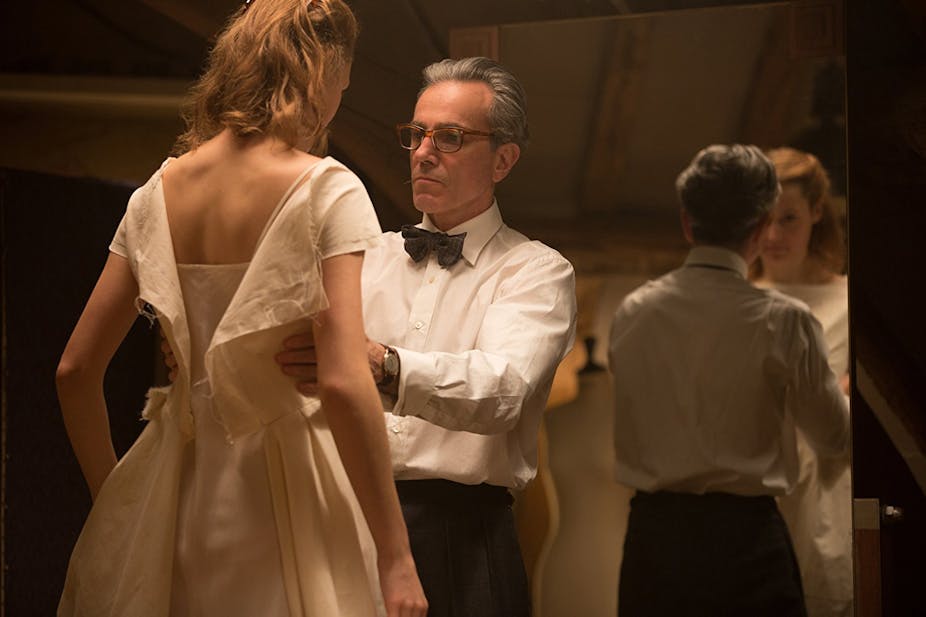Chic! Whoever invented that ought to be spanked in public. I don’t even know what that word means! What is that word? Fucking chic! — Reynolds Woodcock, Phantom Thread (played by Daniel Day Lewis)
In news that has devastated cinephiles the world over, Paul Thomas Anderson’s latest offering will be Daniel Day Lewis’s final performance. Thankfully, the Oscar-nominated Phantom Thread sees a return to the sumptuous echelons achieved by their previous collaboration in There Will Be Blood.
Day-Lewis plays Reynolds Woodcock, a revered fashion designer who demands complete control over his quiet environment. Lesley Manville is inimitable as Cyril, his fierce sister and business partner for their label House of Woodcock.
When Reynolds falls for Alma (Vicky Krieps), an expatriate waitress who soon becomes his muse and paramour, the House of Woodcock undergoes a radical shift. Reynolds initially exerts his control in a brooding passive-aggressive manner, which soon turns into a Hitchcockian-inspired conflict.
Fans of Anderson’s work will pick up on his recurring thematic interests here. At the centre of his films are complicated powerful men who are enigmatic, challenging and ultimately flawed human beings. There is an emphasis on decadence and the protagonist’s conflict with an antagonist. Where Henry Plainview comes up against Eli Sunday in There Will Be Blood, in Phantom Thread Alma continuously tests Reynolds’s boundaries and stifling control.
As always, Anderson makes great use of his close-ups. As Henry Plainview, Day-Lewis completely lost himself in the role, from his limbering walk to his over-pronunciation of each syllable, and ending with his unhinged anger in the now-famous milkshake scene. As Reynolds Woodcock, Day-Lewis offers an initially collected performance, demanding we focus on every minute facial expression.
Day-Lewis’s quiet control is on full display during the several breakfast scenes in the first act. Early on in Alma’s stay at the House of Woodcock, the cracks in Reynolds’s suave demeanour begin to show. With an amplified sound design, Alma noisily scrapes butter across her toast, clangs her cutlery on her plate and slowly pours her tea.
Reynolds’s facial expression is pained, as if he is being sliced open. Disturbing his morning is the biggest sin you could commit against him. There is “entirely too much movement at breakfast” he snaps, which quickly paints him as the iconic tortured — or dare I say toxic? — artist. “It’s like you just rode a horse across the room!”
Vicky Krieps is a revelation here as Alma. The Luxembourg actress holds her own against one of today’s acting greats, which is no mean feat. Much like Day-Lewis, Krieps tells her story through her face. In an interview with Rolling Stone, Anderson speaks of her enigmatic performance:
You look at [Alma] one way and she could not look more awkward; then she turns slightly and, suddenly, she looks stunningly beautiful. Then you see her from a third angle and it’s like: “Does she love me or is she going to poison me?”
Alma is an emigre of unknown origin. We are given very little of her background, just that she speaks with a vaguely German accent and leads an isolated life as a waitress. Given that the film is set in 1955, one can’t help but imagine her childhood as a wartime refugee. The trauma of war is a theme I kept returning to as I left the theatre.
Sound is fundamental to the film’s rising tension. The more Alma acquiesces to Reynolds’s world, the quieter she becomes. The more she challenges him, the louder she is at opening doors or buttering her toast.
Jonny Greenwood’s score shapes the lavishness of the House of Woodcock’s world. In There Will Be Blood, Greenwood’s unusual score is goosebump-inducing and often features twisting staccatos. The opening track, “Wide Open Spaces”, is more akin to a horror film than what we see on the screen. Greenwood’s work for The Master is equally as terrifying.
In Phantom Thread, however, the score matches the beauty of the House of Woodcock’s creations. Used in nearly 70% of the film, Greenwood has created a masterpiece. Influenced by Baroque music, particularly Glenn Gould’s Bach recordings, Greenwood also uses decadent string recordings to give a sense of scale.
Finally, Anderson has listed Hitchcock as one of his seminal influences for the film’s tone. It’s heard in Greenwood’s score, which reminds one of Rebecca, Notorious or Suspicion.
In watching Lesley Manville’s Cyril — Reynolds’s “old sew and sew” — I couldn’t help but think of Mrs Danvers in Rebecca, a character that is often spoken as having queer undertones, as noted in Vito Russo’s The Celluloid Closet. When Cyril first meets Alma — as Reynolds takes her measurements after their first date no less — she looks at Alma in the most peculiar way. I would be interested to hear if anyone else had this reading of Manville’s portrayal of Cyril.
Nevertheless, Anderson channels Hitchcock’s tropes of obsession, neurosis and claustrophobia exquisitely. The film has been nominated for a slew of Academy Awards. Although it faces stiff competition from The Shape of Water, it deserve every accolade it receives.

